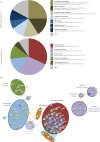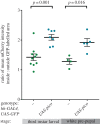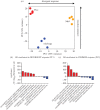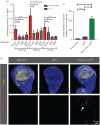Transcriptional responses to hyperplastic MRL signalling in Drosophila
- PMID: 28148822
- PMCID: PMC5356444
- DOI: 10.1098/rsob.160306
Transcriptional responses to hyperplastic MRL signalling in Drosophila
Abstract
Recent work has implicated the actin cytoskeleton in tissue size control and tumourigenesis, but how changes in actin dynamics contribute to hyperplastic growth is still unclear. Overexpression of Pico, the only Drosophila Mig-10/RIAM/Lamellipodin adapter protein family member, has been linked to tissue overgrowth via its effect on the myocardin-related transcription factor (Mrtf), an F-actin sensor capable of activating serum response factor (SRF). Transcriptional changes induced by acute Mrtf/SRF signalling have been largely linked to actin biosynthesis and cytoskeletal regulation. However, by RNA profiling, we find that the common response to chronic mrtf and pico overexpression in wing discs was upregulation of ribosome protein and mitochondrial genes, which are conserved targets for Mrtf/SRF and are known growth drivers. Consistent with their ability to induce a common transcriptional response and activate SRF signalling in vitro, we found that both pico and mrtf stimulate expression of an SRF-responsive reporter gene in wing discs. In a functional genetic screen, we also identified deterin, which encodes Drosophila Survivin, as a putative Mrtf/SRF target that is necessary for pico-mediated tissue overgrowth by suppressing proliferation-associated cell death. Taken together, our findings raise the possibility that distinct targets of Mrtf/SRF may be transcriptionally induced depending on the duration of upstream signalling.
Keywords: Drosophila; MRL proteins; hyperplastic growth; serum response factor; wing development.
© 2017 The Authors.
Figures








References
-
- Rajakylä EK, Vartiainen MK. 2014. Rho, nuclear actin, and actin-binding proteins in the regulation of transcription and gene expression. Small GTPases 5, e27539 (doi:10.4161/sgtp.27539) - DOI - PMC - PubMed
-
- Vartiainen MK, Guettler S, Larijani B, Treisman R. 2007. Nuclear actin regulates dynamic subcellular localization and activity of the SRF cofactor MAL. Science 316, 1749–1752. (doi:10.1126/science.1141084) - DOI - PubMed
-
- Grosse R, Copeland JW, Newsome TP, Way M, Treisman R. 2003. A role for VASP in RhoA-Diaphanous signalling to actin dynamics and SRF activity. EMBO J. 22, 3050–3061. (doi:10.1093/emboj/cdg287) - DOI - PMC - PubMed
-
- Fernandez BG, Gaspar P, Bras-Pereira C, Jezowska B, Rebelo SR, Janody F. 2011. Actin-capping protein and the Hippo pathway regulate F-actin and tissue growth in Drosophila. Development 138, 2337–2346. (doi:10.1242/dev.063545) - DOI - PubMed
-
- Sansores-Garcia L, Bossuyt W, Wada K-I, Yonemura S, Tao C, Sasaki H, Halder G. 2011. Modulating F-actin organization induces organ growth by affecting the Hippo pathway. EMBO J. 30, 2325–2335. (doi:10.1038/emboj.2011.157) - DOI - PMC - PubMed
MeSH terms
Substances
Grants and funding
LinkOut - more resources
Full Text Sources
Other Literature Sources
Molecular Biology Databases
Research Materials
Miscellaneous

